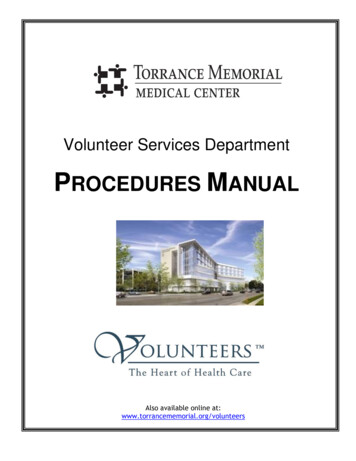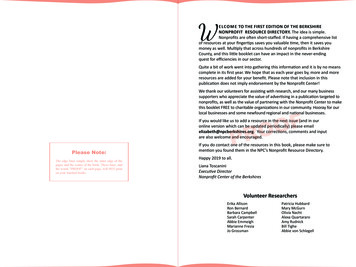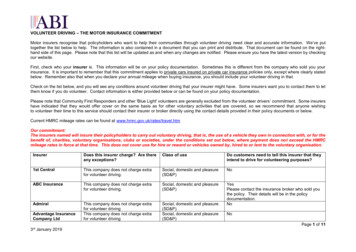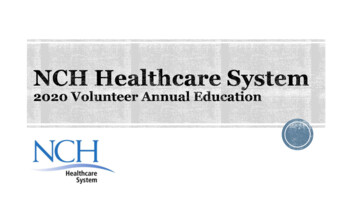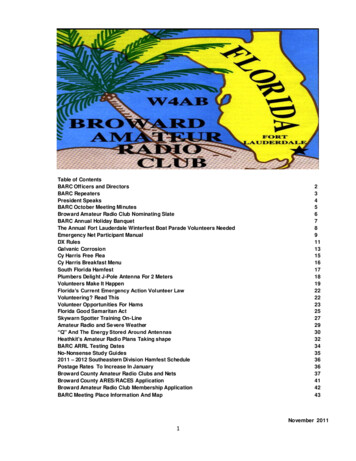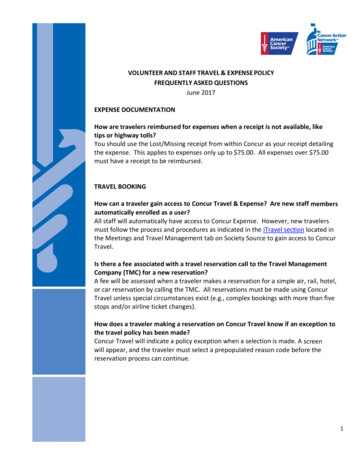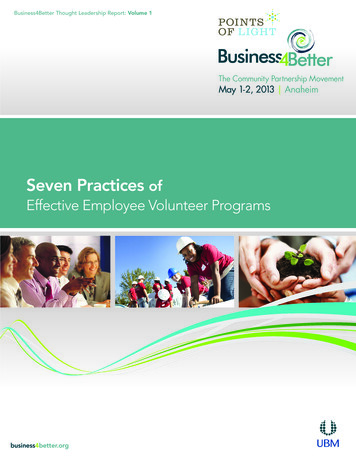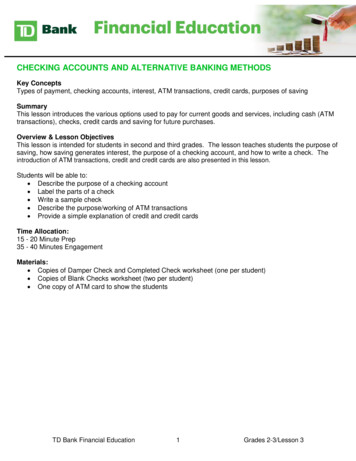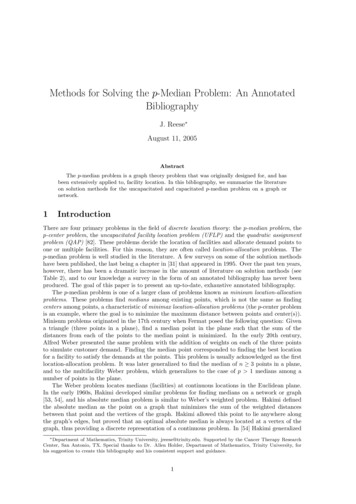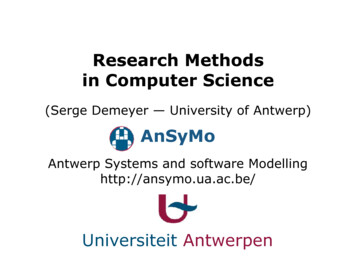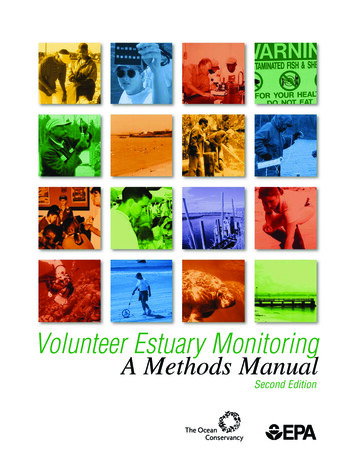
Transcription
Volunteer Estuary MonitoringA Methods ManualSecond Edition
Volunteer Estuary MonitoringA Methods ManualSecond Edition
Volunteer Estuary MonitoringA Methods ManualSecond EditionRonald L. Ohrel, Jr.The Ocean ConservancyKathleen M. RegisterClean Virginia Waterwaysand Longwood UniversityThe Ocean Conservancy2029 K Street, NWSuite 500Washington, DC 20006Phone: 202-429-5609Fax: 202-972-0619Web: www.oceanconservancy.orgU.S. Environmental Protection AgencyOffice of Wetlands, Oceans, and WatershedsVolunteer Monitoring (4504T)1200 Pennsylvania Avenue, NWWashington, DC 20460Phone: 202-566-1200Fax: 202-566-1336E-mail: OW-General@epamail.epa.gov
This document was prepared under Cooperative Agreement #CX825019-01-3 from the U.S. Environmental ProtectionAgency (EPA), Office of Wetlands, Oceans and Watersheds to The Ocean Conservancy.Second Reprint 2006, 2002 The Ocean Conservancy.NOTICE:This document has been reviewed in accordance with U.S. Environmental Protection Agency policy and approvedfor publication. Mention of trade names or commercial products does not constitute endorsementor recommendation for use.Printed on recycled paper using soy-based inks.COVER PHOTOS:Top row (l to r): The Ocean Conservancy, K. Register, The Ocean Conservancy, R. OhrelRow 2 (l to r): K. Register, S. Schultz, Weeks Bay Watershed Project, K. RegisterRow 3 (l to r): L. Monk, The Ocean Conservancy, S. Schultz, E. ElyRow 4 (l to r): T. Monk, The Ocean Conservancy, The Ocean Conservancy, R. Ohrel
AcknowledgementsAcknowledgementsU.S. Environmental Protection Agency Project Officer: Joseph N. Hall, IIThe Ocean Conservancy Project Director: Seba B. SheavlyEditors and Primary Contributors:Ronald L. Ohrel, Jr., The Ocean ConservancyKathleen M. Register, Clean Virginia Waterways and Longwood CollegeProofreader: Elaine HruskaDocument Design and Graphics (except where indicated): Critical StagesThe author of the first edition of this document in 1993 was Nina A. Fisher.The Ocean Conservancy is the nation's leading nonprofit organization dedicated solely to protectingocean environments and marine life in all its abundance and diversity. As part of a cooperativeagreement with the U.S. Environmental Protection Agency (EPA), The Ocean Conservancy conducteda series of train-the-trainer workshops on monitoring estuary environments. Workshop attendeesprovided valuable comments on the first edition of this manual, which helped guide the revision. Wethank them for their time and input.In addition, the following estuary monitoring experts and volunteer monitoring program coordinatorscontributed significantly to this project by submitting case studies and other information:Charles Barr, The Ocean Conservancy; Peter Bergstrom, U.S. Fish and Wildlife Service(Chesapeake Bay Field Office); Eve Brantley, Weeks Bay Watershed Project; Amber Cornell,Adopt A Beach; Carol Elliott, Alliance for a Living Ocean; Eleanor Ely, The Volunteer Monitor;Jon Graves, Portland State University; Holly Greening, Tampa Bay Estuary Program; KerryGriffin, Tillamook Bay National Estuary Project; Linda Hanson, Washington State Departmentof Health; Paul Heimowitz, Oregon State University Extension Sea Grant; Philip L. Hoffman,Tampa BayWatch, Inc.; Harold G. Marshall, Ph.D., Old Dominion University; Lisa Monk, TheOcean Conservancy; Stacey Moulds, Alliance for the Chesapeake Bay; Bob Murphy, Alliancefor the Chesapeake Bay; Seba B. Sheavly, The Ocean Conservancy; and Esperanza Stancioff,University of Maine Cooperative Extension. Portions of this document were excerpted andadapted from other authors, which are referenced in each chapter.The editors also wish to thank the reviewers who offered valuable comments on this document:Cathy Barnette, Dauphin Island Sea Lab/Alabama Department of Economic and CommunityAffairs; Charles Barr, The Ocean Conservancy; Peter Bergstrom, U.S. Fish and WildlifeService (Chesapeake Bay Field Office); Beth Biermann, The Ocean Conservancy; EleanorBochenek, Ph.D., New Jersey Sea Grant; Eve Brantley, Weeks Bay Watershed Project; DavidBuckalew, Ph.D., Longwood College; Barry Burgan, EPA; Diane Calesso, EPA Region 2; KimDonahue, Chesapeake Bay Foundation; Carol Elliott, Alliance for a Living Ocean; Eleanor Ely,The Volunteer Monitor; Joe Farrell, Delaware Sea Grant; Iraida Garcia, Jobos Bay NationalEstuarine Research Reserve; Holly Greening, Tampa Bay Estuary Program; Dominic Gregorio,California State Water Resources Control Board; Kerry Griffin, Tillamook Bay National EstuaryProject; Joseph N. Hall, II, EPA; Paul Heimowitz, Oregon State University Extension Sea Grant;Mark Kutnink, EPA Region 9; George Loeb, EPA; Harold G. Marshall, Ph.D., Old DominioniiiVolunteer Estuary Monitoring: A Methods Manual
AcknowledgementsAcknowledgements continuedUniversity; Alice Mayio, EPA; Gerri Miceli, Gordon Research Conferences; Clara Mojica,Ph.D., Jobos Bay National Estuarine Research Reserve; Lisa Monk, The Ocean Conservancy;Bob Murphy, Alliance for the Chesapeake Bay; Paul Pan, EPA; Jonathan Phinney, Ph.D.,American Society of Limnology and Oceanography; Dominic Roques, California State WaterResources Control Board; Tamara Saltman, EPA; Kathleen Sayce, ShoreBank Pacific;Donald Schulz, Surfrider Foundation (Huntington/Seal Beach Chapter); Seba B. Sheavly, TheOcean Conservancy; Linda Sheehan, The Ocean Conservancy; Frederick Short, Ph.D.,University of New Hampshire; Esperanza Stancioff, University of Maine CooperativeExtension; Edward Stets, EPA; Terry Tamminen, Environment Now; Marie-FrancoiseWalk, Massachusetts Water Watch Partnership; Robert Warren, Columbia River Estuary StudyTaskforce (CREST); and Karen Font Williams, Oregon Department of Environmental Quality.Finally, we would like to thank those individuals and organizations who provided photographs forinclusion in this document:Peter Bergstrom, Gerrit Carver, Eleanor Ely, Maine Department of Marine Resources, LisaMonk, Tim Monk, Bob Murphy, The Ocean Conservancy, PhotoDisc, Ronald Ohrel, M.Redpath, Kathleen Register, Sheila Schultz, Tillamook Bay National Estuary Project andBattelle Marine Science Lab, U.S. Environmental Protection Agency, University of MaineCooperative Extension, and Weeks Bay Watershed Project.ivVolunteer Estuary Monitoring: A Methods Manual
Table of ContentsTable of ContentsAcknowledgements .iiiTable of Contents.vExecutive Summary .xiChapter 1:IntroductionWhere Would Estuaries Be Without Volunteer Monitors? .1-1About the Manual.1-1Purpose of the Manual .1-2Organization of the Manual .1-2How to Use the Manual .1-4References and Further Reading .1-4Chapter 2:Understanding Our Troubled EstuariesOverview .2-1The Science .2-2The Problems.2-5The Solutions.2-8References and Further Reading .2-14Chapter 3:Planning and Maintaining a Volunteer Estuary Monitoring ProgramOverview .3-1Establishing Goals and Objectives.3-2Insurance, Safety, and Liability—Risk Management .3-6Paying for the Program—The Financial Side.3-7Promoting the Program—Working with the Media.3-12References and Further Reading .3-15Chapter 4:Recruiting, Training, and Retaining VolunteersOverview .4-1Recruiting Volunteers .4-2Training Volunteers .4-3Retaining Volunteers .4-11References and Further Reading .4-14Chapter 5:Quality Assurance Project PlanningOverview .5-1The Importance of High Quality Data .5-2What Is a Quality Assurance Project Plan? .5-2Why Develop a QAPP?.5-3Basic Concepts .5-4Quality Control and Assessment .5-10Developing a QAPP .5-13Elements of a QAPP .5-17References and Further Reading .5-22vVolunteer Estuary Monitoring: A Methods Manual
Table of ContentsChapter 6:Sampling ConsiderationsOverview .6-1Four Critical Questions .6-2References and Further Reading .6-7Chapter 7:In the FieldOverview .7-1Fun in the Field .7-2Before Leaving Home .7-3Safety Considerations.7-3What to Bring.7-9Locating Monitoring Sites, or How Do I Get There from Here? .7-10Making Field Observations: Visual Assessments .7-12Helpful Field Measurements .7-14How to Collect Samples.7-15The Data Form .7-17References and Further Reading .7-18Chapter 8:Data Management, Interpretation, and PresentationOverview .8-1After Data Collection: What Does it Mean?.8-2Data Management .8-2Data Interpretation.8-7Data Presentation.8-10References and Further Reading .8-18Unit One: Chemical MeasuresChapter 9:OxygenOverview .9-1Why Monitor Oxygen? .9-2Dissolved Oxygen (DO).9-2Sampling Considerations .9-4How to Monitor Dissolved Oxygen.9-7Biochemical Oxygen Demand (BOD) .9-14Sampling Considerations .9-14How to Measure Biochemical Oxygen Demand .9-15References and Further Reading .9-16Chapter 10: NutrientsOverview .10-1Why Monitor Nutrients? .10-2Sampling Considerations.10-5How to Monitor Nutrients.10-8Special Topic: Atmospheric Deposition of Nutrients.10-11References and Further Reading .10-13viVolunteer Estuary Monitoring: A Methods Manual
Table of ContentsChapter 11: pH and AlkalinityOverview .11-1Why Monitor pH and Alkalinity? .11-2pH .11-2Sampling Considerations .11-3How to Measure pH Values .11-5Total Alkalinity.11-6Sampling Considerations .11-7How to Measure Alkalinity.11-7References and Further Reading .11-10Chapter 12: ToxinsOverview .12-1Toxins in Estuaries .12-2Why Monitor Toxins? .12-2The Role of Toxins in the Estuary Ecosystem.12-3Sampling Considerations.12-7Atmospheric Deposition of Toxins .12-8References and Further Reading .12-8Unit Two: Physical MeasuresChapter 13: TemperatureOverview .13-1Why Monitor Temperature? .13-2Sampling Considerations.13-2How to Monitor Temperature.13-3References and Further Reading .13-5Chapter 14: SalinityOverview .14-1About Salinity .14-2Sampling Considerations.14-3How to Measure Salinity.14-5References and Further Reading .14-7Chapter 15: Turbidity and Total SolidsOverview .15-1Why Measure Turbidity and Total Solids? .15-2Sampling Considerations.15-3How to Measure Turbidity .15-7How to Measure Total Solids.15-10References and Further Reading .15-10viiVolunteer Estuary Monitoring: A Methods Manual
Table of ContentsChapter 16: Marine DebrisOverview .16-1Why Monitor Marine Debris?.16-2Sampling Considerations and Options.16-5How to Conduct a Marine Debris Cleanup.16-7References and Further Reading .16-13Unit Three: Biological MeasuresChapter 17: Bacteria: Indicators of Potential PathogensOverview .17-1Why Monitor Bacteria?.17-2The Bacterial Indicators .17-4How Effective Are the Indicators?.17-6Bacterial Sampling and Equipment Considerations .17-6In the Field: Collecting Water Samples for Bacterial Analysis .17-8In the Lab: Analytical Methods.17-10Which Method and Which Medium Should You Use?.17-14References and Further Reading .17-19Chapter 18: Submerged Aquatic VegetationOverview .18-1Why Monitor SAV?.18-2Sampling Considerations.18-4How to Groundtruth .18-10References and Further Reading .18-14Chapter 19: Other Living OrganismsOverview .19-1Why Monitor Other Living Organisms?.19-2Macroinvertebrates.
U.S. Environmental Protection Agency Office of Wetlands, Oceans, and Watersheds Volunteer Monitoring (4504T) 1200 Pennsylvania Avenue, NW Washington, DC 20460 Phone: 202-566-1200 Fax: 202-566-1336 E-mail: OW-General@epamail.epa.gov The Ocean Conservancy 2029 K Street, NW Suite 500 W
